
The Battle of Gettysburg was a three-day battle in the American Civil War fought between Union and Confederate forces between July 1 and July 3, 1863, in and around Gettysburg, Pennsylvania. The battle, which was won by the Union, is widely considered the Civil War's turning point, ending the Confederacy's aspirations to establish an independent nation. It was the Civil War's bloodiest battle, claiming over 50,000 combined casualties over three days.
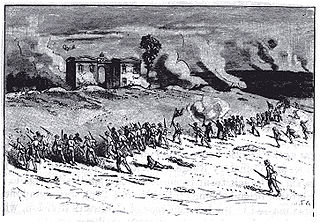
Cemetery Hill is a landform on the Gettysburg Battlefield that was the scene of fighting each day of the Battle of Gettysburg. The northernmost part of the Army of the Potomac defensive "fish-hook" line, the hill is gently sloped and provided a site for American Civil War artillery.

The Battle of Front Royal, also known as Guard Hill or Cedarville, was fought on May 23, 1862, during the American Civil War, as part of Jackson's Valley campaign. Confederate forces commanded by Major General Thomas J. "Stonewall" Jackson were trying to keep Union forces engaged in the Shenandoah Valley to prevent them from joining the Peninsula campaign. After defeating Major General John C. Frémont's force in the Battle of McDowell, Jackson turned against the forces of Major General Nathaniel Banks.

Culp's Hill, which is about 3⁄4 mi (1,200 m) south of the center of Gettysburg, Pennsylvania, played a prominent role in the Battle of Gettysburg. It consists of two rounded peaks, separated by a narrow saddle. Its heavily wooded higher peak is 630 ft (190 m) above sea level. The lower peak is about 100 feet shorter than its companion. The eastern slope descends to Rock Creek, about 160 feet lower in elevation, and the western slope is to a saddle with Stevens Knoll with a summit 100 ft (30 m) lower than the main Culp's Hill summit. The hill was owned in 1863 by farmer Henry Culp and was publicized as "Culp's Hill" by October 31, 1865.
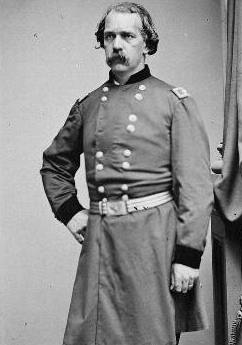
John Henry Hobart Ward was an American soldier who fought in the Mexican–American War and in the American Civil War. Ward joined the army in 1842 and fought in multiple battles in the Mexican–American war, including the Battle of Monterrey, where he was wounded. After leaving the army, he served successively as the assistant commissary general and commissary general for the state of New York. With the outbreak of the American Civil War in 1861, Ward rejoined the army, and became the colonel of the 38th New York Infantry Regiment. Ward and his regiment were engaged in the First Battle of Bull Run and in several battles in the Peninsula campaign. He was promoted to command a brigade after the Battle of Chantilly in September 1862.

The first day of the Battle of Gettysburg during the American Civil War took place on July 1, 1863, and began as an engagement between isolated units of the Army of Northern Virginia under Confederate General Robert E. Lee and the Army of the Potomac under Union Maj. Gen. George G. Meade. It soon escalated into a major battle which culminated in the outnumbered and defeated Union forces retreating to the high ground south of Gettysburg, Pennsylvania.

The 75th Ohio Infantry Regiment, sometimes 75th Ohio Volunteer Infantry was an infantry regiment from southwestern Ohio in the Union Army during the American Civil War. It served in the Eastern Theater, most notably in the battles of Chancellorsville and Gettysburg and then in the siege operations against Charleston, South Carolina.
Jesse Milton Williams commanded a Louisiana regiment in the American Civil War. He briefly held brigade command at the Battle of Gettysburg. Prior to the Civil War, Williams attended the University of Alabama and lived in Mansfield, Louisiana.

The 9th Louisiana Infantry Regiment or Louisiana Tigers was the common nickname for certain infantry troops from the state of Louisiana in the Confederate States Army during the American Civil War. Originally applied to a specific company, the nickname expanded to a battalion, then to a brigade, and eventually to all Louisiana troops within the Army of Northern Virginia. Although the exact composition of the Louisiana Tigers changed as the war progressed, they developed a reputation as fearless, hard-fighting shock troops.
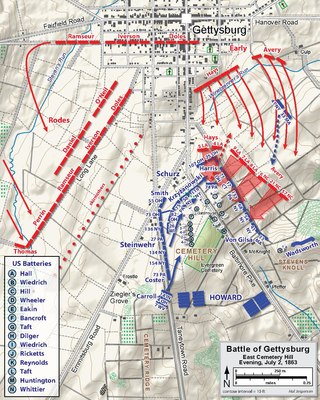
The battle of East Cemetery Hill during the American Civil War was a military engagement on the second day of the Battle of Gettysburg, in which an attack of the Confederacy's Louisiana Tigers Brigade and a brigade led by Colonel Robert Hoke was repelled by the forces of Colonel Andrew L. Harris and Colonel Leopold von Gilsa of the XI Corps, plus reinforcements. The site is on Cemetery Hill's east-northeast slope, east of the summit of the Baltimore Pike.
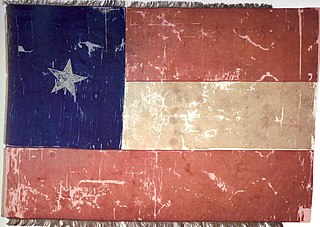
The 5th Texas Infantry Regiment was a unit of Confederate States Army infantry volunteers created in 1861 that fought in the Army of Northern Virginia during the American Civil War. The unit was part of the famous Texas Brigade. The regiment fought at Eltham's Landing, Seven Pines, Gaines's Mill, Second Bull Run, South Mountain, Antietam, and Fredericksburg in 1862. It fought at Gettysburg and Chickamauga in 1863 and the Wilderness, Spotsylvania, Cold Harbor, and the Siege of Petersburg in 1864. The regiment surrendered to Federal forces on 9 April 1865 after the Battle of Appomattox Court House.
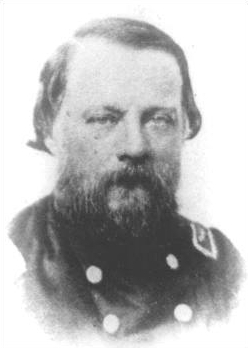
The 1st Louisiana Infantry Regiment was a unit of volunteers recruited in Louisiana that fought in the Confederate States Army during the American Civil War. Formed in April 1861, the regiment was sent to fight in the Eastern Theater of the American Civil War. Joining a brigade of Louisiana regiments, it fought at Malvern Hill, Second Bull Run, Antietam, and Fredericksburg in 1862, at Chancellorsville, Second Winchester, Gettysburg, and Mine Run in 1863, and at the Wilderness, Spotsylvania, Monocacy, Third Winchester, Fisher's Hill, Cedar Creek, and Petersburg in 1864, and at Appomattox in 1865. At Appomattox, the regiment was only a shadow of its former self.
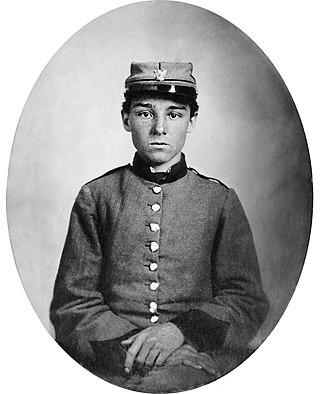
The 2nd Louisiana Infantry Regiment was a unit of volunteers recruited in Louisiana that fought in the Confederate States Army during the American Civil War. Formed in May 1861, the regiment was sent to fight in the Eastern Theater of the American Civil War. Its first action took place during the Siege of Yorktown. The regiment suffered very heavy losses at Malvern Hill. After joining an all-Louisiana brigade, it fought at Cedar Mountain, Second Bull Run, Antietam, and Fredericksburg in 1862, at Chancellorsville, Second Winchester, Gettysburg, and Mine Run in 1863, and at the Wilderness, Spotsylvania, Cold Harbor, Monocacy, Third Winchester, Fisher's Hill, Cedar Creek, and Petersburg in 1864, and at Appomattox in 1865. The regiment lost over 100 men at both Second Bull Run and Chancellorsville. A company-sized remnant surrendered at Appomattox.

The Louisiana Guard Battery was an artillery unit recruited from volunteers in Louisiana that fought in the Confederate States Army during the American Civil War. Formed from an infantry company sent to fight in the Eastern Theater of the American Civil War, it was converted to an artillery company in July 1861. The battery fought at Cedar Mountain, Second Bull Run, Antietam, and Fredericksburg in 1862, and at Chancellorsville, Second Winchester, and Gettysburg in 1863. Most of the soldiers and all of the battery's guns were captured at Rappahannock Station on 7 November 1863. The surviving gunners manned heavy artillery pieces in the defenses of Richmond, Virginia, and the battery's remnant surrendered at Appomattox.

The 12th Louisiana Infantry Regiment was a unit of volunteers recruited in Louisiana that fought in the Confederate States Army during the American Civil War. Formed in August 1861, the regiment served in the Western Theater of the American Civil War and was unique in that there were 12 companies. The regiment garrisoned Island Number Ten before being stationed at Fort Pillow. It fought at Second Corinth in 1862 and Champion Hill and Jackson in 1863. A detachment served during the Siege of Vicksburg and was captured. In 1864, the regiment fought in the Meridian, Atlanta, and Franklin–Nashville campaigns, suffering heavy losses at Peachtree Creek and Franklin. It fought at Bentonville in 1865 before surrendering with General Joseph E. Johnston.

The 8th Louisiana Infantry Regiment was a unit of volunteers recruited in Louisiana that fought in the Confederate States Army during the American Civil War. Formed in June 1861, the regiment was sent to fight in the Eastern Theater of the American Civil War. Joining a brigade of Louisiana regiments, it fought in Jackson's Valley campaign and at Gaines' Mill, Malvern Hill, Second Bull Run, Antietam, and Fredericksburg in 1862. The regiment served at Chancellorsville, Second Winchester, Gettysburg in 1863. At Rappahannock Station in November 1863, most of the regiment was captured. The unit fought at the Wilderness, Spotsylvania, Cold Harbor, and the Valley campaigns of 1864. It served at Petersburg starting in December 1864 and surrendered at Appomattox in April 1865.

The 4th Louisiana Infantry Regiment was a unit of volunteers recruited in Louisiana that fought in the Confederate States Army during the American Civil War. Formed in May 1861, the regiment served in the Western Theater of the American Civil War. The unit fought at Shiloh and Baton Rouge in 1862 and at Jackson in 1863. A detachment served during the Siege of Port Hudson and was captured. In 1864, the regiment fought in the Atlanta campaign where it lost heavily at Jonesborough. At Nashville in December 1864 most of the men were captured. The survivors were consolidated with several other units and fought at Spanish Fort in April 1865. The remnant surrendered in May 1865.

The 7th Louisiana Infantry Regiment was a unit of volunteers recruited in Louisiana that fought in the Confederate States Army during the American Civil War. Formed in June 1861, the regiment was sent to fight in the Eastern Theater of the American Civil War. After fighting at First Bull Run, the unit joined the 1st Louisiana Brigade. The regiment served in Jackson's Valley campaign and at Gaines' Mill, Malvern Hill, Cedar Mountain, Second Bull Run, Harpers Ferry, Antietam, and Fredericksburg in 1862. The regiment fought at Chancellorsville, Second Winchester, and Gettysburg in 1863. At Rappahannock Station in November 1863, almost the entire regiment was captured. The remnant of the unit fought at the Wilderness, Spotsylvania, Cold Harbor, and the Valley campaigns of 1864. It served at Petersburg starting in December 1864 and surrendered at Appomattox in April 1865.

The 20th Louisiana Infantry Regiment was a unit of volunteers recruited in Louisiana that fought in the Confederate States Army during the American Civil War. The unit began its existence as the 6th Louisiana Battalion in September 1861. The battalion was augmented to regimental strength in January 1862 at New Orleans and served during the war in the Western Theater of the American Civil War. The regiment fought at Shiloh, Farmington, and Perryville in 1862. After being reduced in numbers, the regiment was consolidated with the 13th Louisiana Infantry Regiment and served at Stones River, Jackson, Chickamauga, and Missionary Ridge in 1863. The 13th-20th Consolidated Louisiana fought at Resaca, New Hope Church, Ezra Church, and Nashville in 1864. The consolidation with the 13th Louisiana was discontinued in February 1865 and the regiment was re-consolidated with other units. It fought its final battle at Spanish Fort one month before surrendering in May 1865.

The 13th and 20th Consolidated Louisiana Infantry Regiment was a unit of volunteers recruited in Louisiana that fought in the Confederate States Army during the American Civil War. It served only in the Western Theater. The unit was created in November 1862 by combining the veteran but diminished 13th Louisiana and 20th Louisiana Infantry Regiments to form the consolidated regiment. The regiment fought at Stones River, Jackson, Chickamauga, and Missionary Ridge in 1863. The 13th-20th Louisiana fought at Resaca, New Hope Church, Ezra Church, Jonesborough, and Nashville in 1864. The consolidation was discontinued in February 1865 and the 13th and 20th Infantry Regiments were re-consolidated with other units.




















